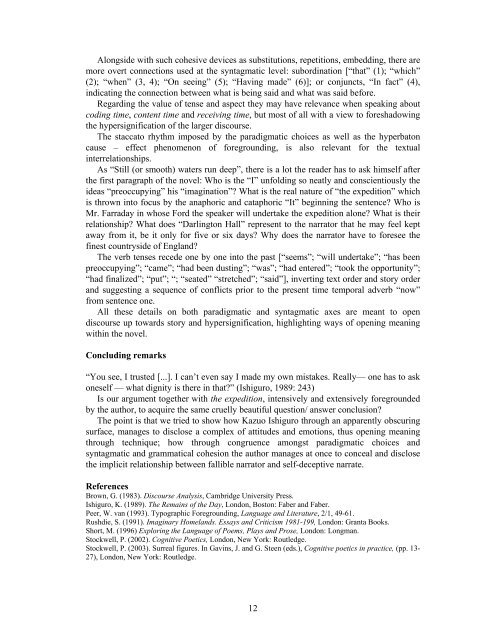PDF. - full text
PDF. - full text
PDF. - full text
You also want an ePaper? Increase the reach of your titles
YUMPU automatically turns print PDFs into web optimized ePapers that Google loves.
Alongside with such cohesive devices as substitutions, repetitions, embedding, there are<br />
more overt connections used at the syntagmatic level: subordination [“that” (1); “which”<br />
(2); “when” (3, 4); “On seeing” (5); “Having made” (6)]; or conjuncts, “In fact” (4),<br />
indicating the connection between what is being said and what was said before.<br />
Regarding the value of tense and aspect they may have relevance when speaking about<br />
coding time, content time and receiving time, but most of all with a view to foreshadowing<br />
the hypersignification of the larger discourse.<br />
The staccato rhythm imposed by the paradigmatic choices as well as the hyperbaton<br />
cause – effect phenomenon of foregrounding, is also relevant for the <strong>text</strong>ual<br />
interrelationships.<br />
As “Still (or smooth) waters run deep”, there is a lot the reader has to ask himself after<br />
the first paragraph of the novel: Who is the “I” unfolding so neatly and conscientiously the<br />
ideas “preoccupying” his “imagination”? What is the real nature of “the expedition” which<br />
is thrown into focus by the anaphoric and cataphoric “It” beginning the sentence? Who is<br />
Mr. Farraday in whose Ford the speaker will undertake the expedition alone? What is their<br />
relationship? What does “Darlington Hall” represent to the narrator that he may feel kept<br />
away from it, be it only for five or six days? Why does the narrator have to foresee the<br />
finest countryside of England?<br />
The verb tenses recede one by one into the past [“seems”; “will undertake”; “has been<br />
preoccupying”; “came”; “had been dusting”; “was”; “had entered”; “took the opportunity”;<br />
“had finalized”; “put”; “; “seated” “stretched”; “said”], inverting <strong>text</strong> order and story order<br />
and suggesting a sequence of conflicts prior to the present time temporal adverb “now”<br />
from sentence one.<br />
All these details on both paradigmatic and syntagmatic axes are meant to open<br />
discourse up towards story and hypersignification, highlighting ways of opening meaning<br />
within the novel.<br />
Concluding remarks<br />
“You see, I trusted [...]. I can’t even say I made my own mistakes. Really— one has to ask<br />
oneself — what dignity is there in that?” (Ishiguro, 1989: 243)<br />
Is our argument together with the expedition, intensively and extensively foregrounded<br />
by the author, to acquire the same cruelly beautiful question/ answer conclusion?<br />
The point is that we tried to show how Kazuo Ishiguro through an apparently obscuring<br />
surface, manages to disclose a complex of attitudes and emotions, thus opening meaning<br />
through technique; how through congruence amongst paradigmatic choices and<br />
syntagmatic and grammatical cohesion the author manages at once to conceal and disclose<br />
the implicit relationship between fallible narrator and self-deceptive narrate.<br />
References<br />
Brown, G. (1983). Discourse Analysis, Cambridge University Press.<br />
Ishiguro, K. (1989). The Remains of the Day, London, Boston: Faber and Faber.<br />
Peer, W. van (1993). Typographic Foregrounding, Language and Literature, 2/1, 49-61.<br />
Rushdie, S. (1991). Imaginary Homelands. Essays and Criticism 1981-199, London: Granta Books.<br />
Short, M. (1996) Exploring the Language of Poems, Plays and Prose, London: Longman.<br />
Stockwell, P. (2002). Cognitive Poetics, London, New York: Routledge.<br />
Stockwell, P. (2003). Surreal figures. In Gavins, J. and G. Steen (eds.), Cognitive poetics in practice, (pp. 13-<br />
27), London, New York: Routledge.<br />
12












